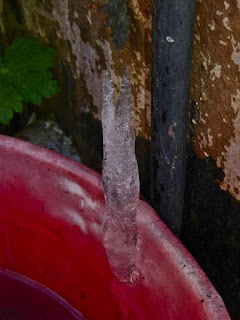December and January... and a Scottish Garden Saint!
I made this tall jug (or pitcher) for someone who wanted me to make a garden saint, rather like St Fiacre (the patron Saint of growers of vegetables and medicinal plants), but with a Scottish flavour. I think the jug ended up at about 14 inches high when fired (35.5 cm).
A most interesting treasure hunt with Google brought to light several images of St Fiacre and also a watercolour that is reputed to be the earliest known depiction of a Scotsman in a kilt. I was able to combine Fiacre and the Scotsman in my little illustration of the Saint. I used black under glaze on raw clay for the line work. The illustration was waxed before I glazed the rest of the jug so as to keep the Saint free of glaze.
I might do a post just about making and glazing the Scottish Garden Saint jug as there were some techniques that I used for the illustration that might be of interest to someone.
Making a large jug led quite naturally to making several more of assorted sizes.

I also experimented further with the glaze that I used on the Scottish Garden Saint jug. On a buff stoneware clay it gives a cool white and green depending on thickness.
In a glaze firing of the electric kiln where I "fired down" from the peak temperature in order to slow the rate of cooling I was able to get very distinct small crystals to grow over a dark background. The crystal growth showed up particularly well on this bowl.
When I make mugs I still search for the "perfect form"... Of course that is largely a matter of individual preference, but I do like the comforting "cuddly" shape of these mugs. The slight, but definite, flare out toward the rim of the mug, makes them more pleasant to drink out of, and also helps keep the mug round when it is being fired in the kiln.
I have been experimenting with this cobalt blue glaze. It is one of those fascinating ones that gives two or three colours depending on glaze thickness, and also turns green when titanium is added to it... either as titanium dioxide or as rutile.
Here is the same "blue" glaze as the previous example, but this one has 4 percent rutile added to it which has made blue turn green. The glaze has a nice "waxy" feel to it, and works well on both white and buff coloured stoneware.
We had some lovely people through our little gallery over the summer season, and we have greatly appreciated meeting new people and also having repeat visits from previous customers. Due to the strange world that we all live in since Covid, we had no idea ahead of summer how busy or quiet we would be, but it was actually a comparatively good season for us.
Due to very indifferent health I have found it particularly difficult this time round to make sufficient pots to have here for sale, but we haven't run out, although there have been occasions when we almost had no bowls or mugs here. Whilst I am determined to still keep making pots, and other things that interest me, I think I am going to have to say "no" to most commissions in future. These days I keep falling behind with such things or completely forgetting them, which is sad... and I hate letting people down.
Here's that blue glaze again! Pale blue, dark blue, and almost black.... depending on glaze thickness. It is really most entertaining!
















Comments
Thank you for writing in, and with a "bonus" comment too! I do like making jugs, they can have a great deal of character, often human or bird-like. Years ago I bought a small oil bottle by Mirek Smisek, and it has the alert watchfulness of a little sparrow as it sits up there on my shelf.
Commissions almost always are difficult to some degree as they usually involve making something "one off"... and so much of potting depends on making a series of objects in order to iron out technical challenges and become proficient at making them. When I was "in my prime" I enjoyed doing them, as I always learned a lot along the way, but now that the body has decided that it is past its "best by", I find I keep falling behind with things... 3 days, becomes 3 weeks, etc... Frustrating, but it is something one has to adapt to.
Best Wishes,
Peter